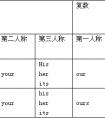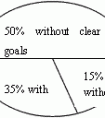_______ of the land in that district _______ covered with trees and grass.[ ]A. Two fifths; is B. Two fifth; are C. Two fifth; is D. Two fifths; are -九年级英语
There are three chairs, a desk and a computer in the room. 房间里有3把椅子、一张书桌和一台电脑。
Where is your wife and children to stay while you are away?你不在时妻子和孩子呆在哪儿?
"表里不一"现象:
主谓一致中的"表里不一"现象
和主语必须在人称和数上保持一致,最基本的原则是:单数主语用单数动词,复数主语用复数动词.但在实际使用当中情况比较复杂,现在学生常犯的主谓一致错误归纳整理如下
1,"more than one +名词"作主语时,谓语动词常用单数.例如:
More than one teacher gets the flowers. 不止一个教师得到了花.
2,"many a +名词"作主语时,从意义上看是复数,但谓语动词常用单数.例如:
Many a student has been sent to plant trees. 很多学生被派去植树.
3,"half of,the rest of,most of,all of及百分数或分数+of 等后接名词"作主语时,谓语动词形式根据of后的名词而定.例如:
Three fourths of the surface of the earth is covered with water.地球表面四分之三为水所覆盖.
4,all指人时,动词用复数;all指物时,动词用单数.例如:
"All are present and all is going well." 所有人全部到场了,一切进展顺利
5,what引导的主语从句,谓语动词可视表语而定:表语是单数名词时,动词用单数,相反,则用复数.例如:
What they want to get are a number of good books.他们想得到的是大量的好书.
6,and连接的两个单数名词前若用each,every,no修饰,该名词短语作主语时,谓语动词用单数形式.例如:
No book and no pen is found in the schoolbag.书包里没有书和钢笔.
7,当主语后面有as well as,with,along with,together with,but,like,rather than,except,逗号加and连接几个名字等引导的短语时,谓语动词要与最前面的主语保持一致.例如:
My father as well as his workmates has been to Beijing. 我父亲和他的同事曾去过北京.
8,each作主语的同位语时,谓语动词由主语来决定,与each无关.例如:
They each have a bike. 他们每人有一辆自行车.
9,动词不定式,动词-ing形式短语作主语时,谓语动词常用单数.例如:
Going out for a walk after supper is a good habit.晚饭后出去散步是一个好习惯.
10,the following作主语时,谓语动词的数与后面名词的数保持一致.例如:
The following are good examples下面是一些好例子.
11,以-ics结尾的学科名词,如politics,physics,mathematics等作主语时,谓语动词用单数.以-s结尾的名词news,works,plastics等同属此类.例如:
Politics is now taught in all schools. 现在各学校都开设政治课.
当以-ics结尾的学科名词表示"学科"以外的意义时,用作复数,如:mathematics(运算能力)politics(政治观点)economics(经济意义)等
12,有些用来表示由两个对应部分组成一体的名词复数(trousers,glasses,shoes.shorts.scissors.scales等)作主语时,前面若有"一条","一副","一把"之类的单位词,动词用单数;若没有单位词或单位词是复数,则谓语动词用复数.例如:
The shoes are all right. 这些鞋子都很合适.
还有一些以-s结尾的名词通常用复数:arms(武器).clothes.contents.minites(记录).remains(遗体).thanks等
13,"one and a half +名词"作主语时,谓语动词要用复数.例如:
One and a half apples are left on the table. 桌子上有一个半苹果.
14,"One or two more +复数名词"作主语时,谓语动词用复数.例如:
One or two persons are sent there to help them do the work. 要派一两个人到那儿去给他们帮忙.
15,"one of+复数名词+ 定语从句"结构中,定语从句的谓语动词要用复数;而在"the only one of +复数名词+定语从句"的结构中,"the one of + 复数名词+定语从句"定语从句的谓语动词要用单数.例如:
He is one of the students who get there on time.他是准时到达那里的学生之一.
16,表示时间,距离,金钱等的复数名词作主语表达一个整体概念时,谓语动词常用单数,但若强调数量,谓语动词可用复数.例如:
One million dollars is a lot of money. 一百万美元是一大笔钱.
英语可数名词的规则复数形式是在词尾加-s或-es,但是有一些以-s结尾的名词并不是可数名词。
它们用法多样,造成了实际使用上的困难,以下详述了以-s结尾的名词作主语的主谓一致问题。
(一)以-s结尾的疾病名称作主语的主谓一致问题
(二)以-s结尾的游戏名称作主语的主谓一致问题
(三)以-s结尾的地理名称作主语的主谓一致问题
(四)以-ics结尾的学科名称作主语的主谓一致问题
(五)其它以-s结尾的名词的主谓一致问题
集合名词的主谓一致原则:
集合名词作主语时,主谓一致关系是一个较为复杂的问题.对此类问题我们可以从"数"的角度分为四类.
1)单数—复数型.凡是有复数词尾变化形式的集合名词都属于此类。如:
a class—classes; a family—families; a government—governments; an army—armies; a people—peoples; a group—groups; a crowd—crowds; a crew—crews等。
这类集合名词强调的是整体性,即当作一个整体或多个整体来看待。属于这类集合名词的单数作主语时,谓语动词用单数;
复数形式作主语时,谓语动词用复数。
【例如】
A big crowd often gathers on the square every morning.
每个上午 一大群人经常聚集在广场上
The government has decided to pass the bill.
政府已决定通过这一法案
There are huge crowds in the streets on Sunday.
星期天有大群大群的人在街上。
There are many English-speaking peoples in the world.
在世界上有许多讲英语的人
但应注意,这类集合名词的单数形式有时表示复数概念,所以这些集合名词的单数形式也可归为"单复同形型"中.
2)单数型.这类集合名词表示的是人或事物的整体,即把这类人或事物的全部包括在内,所以只有单数形式.如作主语,谓语动词常用单数。
这类名词常见的有:humanity,mankind,proletariat等.
【例如】The proletariat is the greatest class in the history of mankind. In the fields of production and scientific experiment,mankind makes constant progress.
3)复数型.这类集合名词在形式和内容上是相互矛盾的,就是说它们只有单数形式,但表达的都是复数概念。它强调的是集体中的个体性.这类名词有:police,cattle,faculty,flock,machinery,vermin,personnel等.它们作主语时,谓语动词要用复数.
【例如】The police have caught the murder.
Our personnel are very highly trained.
The vermin are very dangerous.
4)单复同形型.这类集合名词的单数形式既可表示单数也可表示复数.作主语时,用单数动词或复数动词均可,有时意义区别不大.
【例如】The school teaching staff are (is) excellent.
The public is (are) requested not to litter in the park.
The teaching profession claim(s) to be badly paid.
这类集合名词常见的有:class,family,team,crew,board,herd,committee,party,jury,enemy,audience等.
根据说话人的心理意向若把这个集合名词所代表的人或事物看作一个整体,就认为是单数,用单数动词;
若把它所代表的人或事物看作若干个个体的话,就认为其为复数,用复数动词。
试比较:The football team is playing well.
那个足球队打得非常漂亮.
The football team are shavings bath and are then coming back here for tea. 足球队员们正在洗澡,然后来这里吃茶点。
The family is a very happy one.那个家庭是一个非常幸福的家庭。
That family are very pleased about the news of William's success. 全家人对威廉的成功都感到很高兴。
巧记主谓一致原则:
单单复复最常见,集体名词谓用单,如若强调其成员,复数谓语记心间。
有些名词谓常复,people,police即这般。主语单数后接介,谓语单数介无关,
many a作主语也如此,谓语动词应用单。or、nor、but also、there be,近主原则挂嘴边。
关系代词定主语,谓语根据先行词判。不定式短语、动名词,主语从句谓全单。
时间、货币与距离,谓语多单复少见,rest,means,fol1owing等,意义决定其复、单。
none,all,half of等,of之宾语定答案。还有分数、百分数,仍据of之宾定复、单。
代词all指人谓复数,all指事情谓用单。量词用法请注意,谓语要随量词变。
and连接两名词,身兼两职一定冠,no,each,every后单名,两件(种)事(物)系一概念,
以上情况请记清,谓语动词全用单。形容词带the一类人,姓氏复数加定冠,
-s结尾的海峡、山脉与群岛,谓语用复勿用单。neither,either,each,用作主语谓全单。
- 最新内容
- 相关内容
- 网友推荐
- 图文推荐
| [家长教育] 孩子为什么会和父母感情疏离? (2019-07-14) |
| [教师分享] 给远方姐姐的一封信 (2018-11-07) |
| [教师分享] 伸缩门 (2018-11-07) |
| [教师分享] 回家乡 (2018-11-07) |
| [教师分享] 是风味也是人间 (2018-11-07) |
| [教师分享] 一句格言的启示 (2018-11-07) |
| [教师分享] 无规矩不成方圆 (2018-11-07) |
| [教师分享] 第十届全国教育名家论坛有感(二) (2018-11-07) |
| [教师分享] 贪玩的小狗 (2018-11-07) |
| [教师分享] 未命名文章 (2018-11-07) |

![_____ of the soldiers are young people.[]A. Two thirdB. Two thirdsC. Second threeD. Two threes-九年级英语](http://www.00-edu.com/d/file/ks/4/2/fenshu/2019-11-29/smallf243cdec8b100d13fdb8c6c7cdd2021a1574983320.jpg)

![Nowadays____of business letters are written in English.[ ]A. two thirdB. two thirdsC. two threeD. second three-九年级英语](http://www.00-edu.com/d/file/ks/4/2/fenshu/2019-11-29/smallc973f30047581056bd363c502e0a09451574983317.jpg)
![It is said that about ______ of the books and magazines in the world ______ in English.[ ]A. four-fifths;are writtenB. fourth fives;are writtenC. four fift-九年级英语](http://www.00-edu.com/d/file/ks/4/2/fenshu/2019-11-29/smalld6893b11e01e4ca3d7ba34ba5bfa78fd1574983286.jpg)

